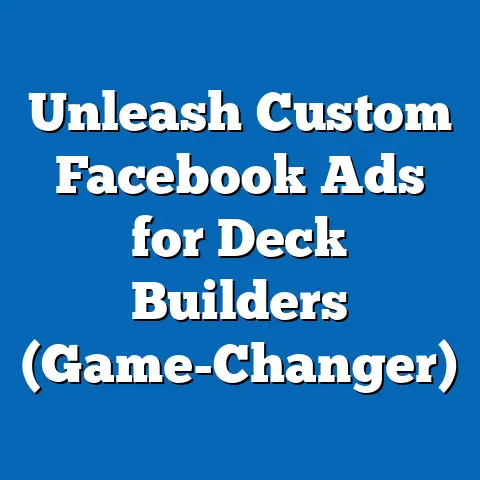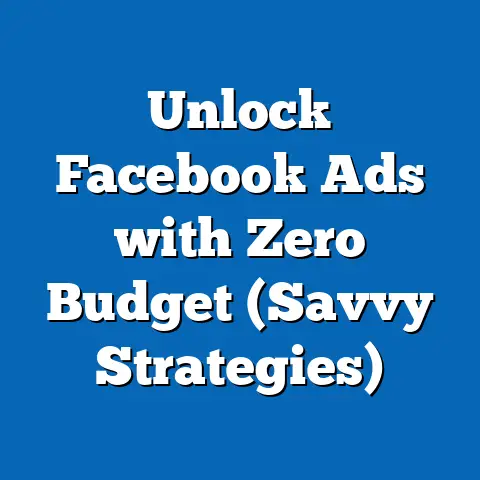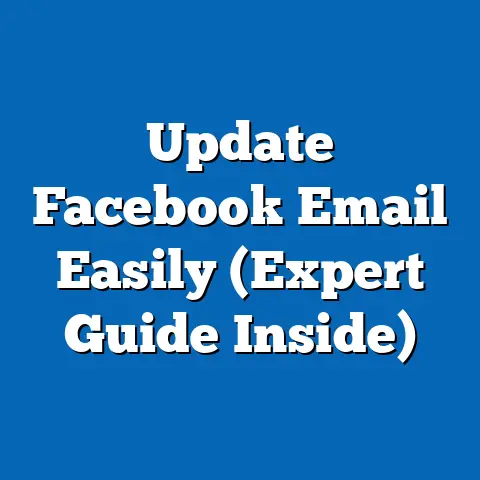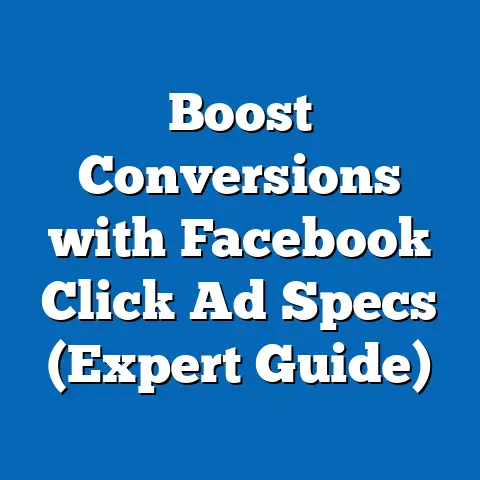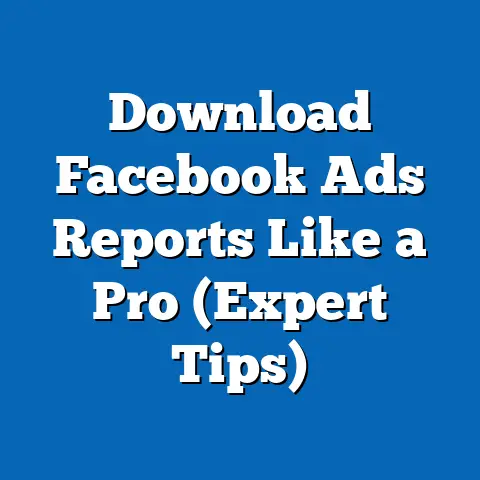Are Facebook Ads the Same as Instagram? (Insights Unveiled)
As the leaves change color and the air turns crisp, one thing is certain: the holiday shopping season is just around the corner. It’s a time when businesses of all sizes are gearing up, dusting off their marketing plans, and preparing to capture the attention (and wallets) of eager consumers. And in today’s digital landscape, that means one thing: social media advertising.
Facebook and Instagram, the twin titans of the social media world, are undoubtedly at the forefront of these efforts. Millions of businesses leverage these platforms to reach their target audiences, promote their products, and drive sales. But here’s the million-dollar question: are Facebook Ads and Instagram Ads the same thing? Can you simply create one ad and expect it to perform equally well on both platforms?
The short answer? No.
While both platforms share a common parent (Meta) and a unified ad management system, the similarities largely end there. Facebook and Instagram offer distinct user experiences, cater to different demographics, and thrive on unique content formats. Understanding these nuances is crucial for crafting effective advertising strategies that resonate with your target audience and deliver a solid return on investment.
My goal is to provide you with a clear understanding of how these two platforms can be utilized effectively in your marketing strategies, ensuring that you’re not just throwing money at ads, but strategically investing in channels that will drive real results. So, let’s get started!
1. Overview of Facebook and Instagram as Advertising Platforms
To truly understand the differences and similarities between Facebook and Instagram ads, we first need to understand the platforms themselves. Both have a rich history, distinct audiences, and a range of advertising options.
1.1 Brief History and Evolution
Facebook, launched in 2004, initially started as a social networking site for Harvard students. Its growth was meteoric, quickly expanding to other universities and eventually the entire world. The introduction of Facebook Ads in 2007 revolutionized how businesses could reach potential customers. The key innovation was the ability to target users based on their demographics, interests, and behaviors – a level of precision previously unheard of in advertising.
Over the years, Facebook Ads has evolved significantly. From simple text-based ads to sophisticated video and carousel formats, the platform has continually adapted to changing user behavior and technological advancements. The acquisition of Instagram in 2012 was a pivotal moment, setting the stage for the integration of advertising across both platforms.
The integration of Facebook and Instagram’s advertising platforms has made it easier for businesses to manage their campaigns across both channels. However, this integration also necessitates a nuanced understanding of each platform’s strengths and weaknesses. I’ve seen many businesses treat them as interchangeable, and the results are almost always disappointing.
1.2 Audience Demographics
One of the most significant differences between Facebook and Instagram lies in their audience demographics. While there is overlap, each platform attracts a distinct user base.
Facebook:
- Age: Facebook boasts a broad age range, with a significant portion of its users aged 25-54. While younger demographics are still present, they are less dominant than on Instagram.
- Gender: The gender distribution on Facebook is relatively balanced, with a slight lean towards female users in some regions.
- Location: Facebook has a global presence, with users from virtually every country. However, its penetration varies by region, with higher adoption rates in developed countries.
- Interests: Facebook users engage with a wide range of content, from news and current events to personal updates and community groups. This diversity makes it a versatile platform for reaching a broad audience with varied interests.
Instagram:
- Age: Instagram is particularly popular among younger demographics, with a large concentration of users aged 18-34. This makes it an ideal platform for reaching millennials and Gen Z.
- Gender: Instagram tends to skew slightly towards female users, although the gender distribution is becoming more balanced over time.
- Location: Like Facebook, Instagram has a global presence, but its popularity is particularly strong in urban areas and among younger populations.
- Interests: Instagram users are primarily interested in visual content, including photos, videos, and Stories. Popular topics include fashion, beauty, travel, food, and lifestyle.
Understanding these demographic differences is crucial for tailoring your advertising campaigns. For example, if you’re targeting young adults interested in fashion, Instagram might be a more effective platform than Facebook. Conversely, if you’re targeting older adults interested in news and current events, Facebook might be a better choice.
I remember working with a client who was launching a new skincare product aimed at women aged 45+. They initially focused their advertising efforts on Instagram, assuming that all women were active on the platform. However, after analyzing their campaign performance, we discovered that their target audience was far more responsive to Facebook ads. By shifting their budget and tailoring their messaging to Facebook users, they saw a significant increase in sales.
1.3 Advertising Options Available
Both Facebook and Instagram offer a variety of advertising options to suit different business goals and budgets. These options include:
- Image Ads: Single image ads are a simple and effective way to showcase your product or service. They are ideal for visually appealing products and can be used to drive traffic to your website or landing page.
- Video Ads: Video ads are highly engaging and can be used to tell a story, demonstrate a product, or build brand awareness. They are particularly effective on both Facebook and Instagram, but require high-quality production to stand out.
- Carousel Ads: Carousel ads allow you to showcase multiple images or videos in a single ad unit. This format is ideal for highlighting different features of a product, showcasing a collection, or telling a story in a sequential manner.
- Collection Ads: Collection ads are designed to drive product discovery and sales. They feature a hero image or video, along with a selection of related products that users can browse and purchase directly from the ad.
- Stories Ads: Stories ads are full-screen, vertical ads that appear between users’ Stories. They are highly immersive and can be used to drive brand awareness, engagement, and conversions.
- Lead Ads: Lead ads are designed to collect leads directly from users within the Facebook or Instagram app. They are ideal for generating interest in your product or service and building your email list.
- Instant Experience Ads: Instant Experience ads (formerly known as Canvas ads) are full-screen, interactive ads that open when a user clicks on your ad. They allow you to create a rich and engaging experience that showcases your product or service in detail.
While most of these ad formats are available on both platforms, there are some nuances to consider. For example, Instagram is particularly well-suited for visually appealing content, while Facebook is more versatile and can accommodate a wider range of ad formats and messaging styles.
Key Takeaway: Understanding the history, audience demographics, and advertising options available on Facebook and Instagram is crucial for developing effective advertising strategies. Tailor your campaigns to each platform’s unique characteristics to maximize your results.
2. Similarities Between Facebook Ads and Instagram Ads
Despite their differences, Facebook and Instagram Ads share several key similarities that make them a powerful combination for marketers. These similarities primarily stem from their shared infrastructure and advertising platform.
2.1 Shared Ad Manager
The most significant similarity between Facebook and Instagram Ads is that they are both managed through the Facebook Ads Manager. This unified platform allows advertisers to create, manage, and track their campaigns across both channels from a single interface.
The Facebook Ads Manager provides a range of tools and features, including:
- Campaign Creation: You can create new campaigns, set your objectives, and define your target audience.
- Ad Set Management: You can manage your ad sets, set your budget, and schedule your ads.
- Ad Creation: You can create your ads, upload your creative assets, and write your ad copy.
- Reporting and Analytics: You can track your campaign performance, analyze your results, and optimize your ads.
The benefits of using a unified platform for ad management are numerous:
- Efficiency: You can save time and effort by managing your campaigns across both platforms from a single interface.
- Consistency: You can ensure consistency in your branding and messaging across both channels.
- Optimization: You can optimize your campaigns based on data from both platforms, allowing you to make more informed decisions.
- Simplified Reporting: You can generate comprehensive reports that provide a holistic view of your advertising performance across both Facebook and Instagram.
I’ve personally found the Ads Manager to be incredibly powerful, especially when managing campaigns for clients with a presence on both platforms. The ability to A/B test different ad creatives and targeting options, and then quickly apply the winning strategies across both Facebook and Instagram, is a huge time-saver.
2.2 Targeting Capabilities
Another key similarity between Facebook and Instagram Ads is their sophisticated targeting capabilities. Both platforms leverage Facebook’s extensive data on its users to allow advertisers to reach their ideal audience with incredible precision.
The targeting options available on both platforms include:
- Demographic Targeting: You can target users based on their age, gender, location, education, relationship status, and other demographic factors.
- Interest-Based Targeting: You can target users based on their interests, hobbies, and activities. Facebook tracks user behavior across its platform and uses this data to infer their interests.
- Behavioral Targeting: You can target users based on their past behavior, such as their purchase history, website visits, and app usage.
- Custom Audiences: You can upload your own customer data, such as email addresses or phone numbers, to create custom audiences. This allows you to target your existing customers with relevant ads.
- Lookalike Audiences: You can create lookalike audiences based on your existing customers or website visitors. This allows you to reach new users who are similar to your best customers.
These targeting options can be combined to create highly specific audiences. For example, you could target women aged 25-34 who live in New York City, are interested in fashion, and have recently visited your website. This level of precision allows you to deliver highly relevant ads to your target audience, increasing the likelihood of engagement and conversions.
I once worked on a campaign for a local bakery that wanted to promote its new line of vegan cupcakes. We used Facebook’s targeting options to reach users who were interested in veganism, baking, and local restaurants. We also created a custom audience based on their existing email list and a lookalike audience based on their website visitors. The results were fantastic, with a significant increase in foot traffic and online orders.
2.3 Performance Metrics and Analytics
Both Facebook and Instagram Ads offer robust performance metrics and analytics that allow advertisers to track their campaign performance and measure their ROI. These metrics include:
- Impressions: The number of times your ad was shown to users.
- Reach: The number of unique users who saw your ad.
- Clicks: The number of times users clicked on your ad.
- Click-Through Rate (CTR): The percentage of users who saw your ad and clicked on it.
- Cost Per Click (CPC): The average cost you paid for each click on your ad.
- Conversions: The number of users who completed a desired action, such as making a purchase or filling out a form.
- Conversion Rate: The percentage of users who clicked on your ad and completed a desired action.
- Cost Per Conversion (CPC): The average cost you paid for each conversion.
- Return on Ad Spend (ROAS): The amount of revenue you generated for every dollar you spent on advertising.
These metrics can be used to assess the effectiveness of your campaigns and identify areas for improvement. For example, if your CTR is low, you might need to improve your ad copy or creative. If your CPC is high, you might need to refine your targeting options. If your ROAS is low, you might need to re-evaluate your overall advertising strategy.
Facebook and Instagram also offer advanced analytics tools that allow you to delve deeper into your campaign performance. These tools include:
- Facebook Pixel: A piece of code that you can install on your website to track user behavior and measure conversions.
- Facebook Analytics: A comprehensive analytics platform that provides insights into your website traffic, app usage, and customer behavior.
By tracking these metrics and analyzing your results, you can continuously optimize your campaigns and improve your ROI. I always tell my clients that data is their best friend. The more you analyze your performance, the better equipped you are to make informed decisions and drive results.
Key Takeaway: The shared Ad Manager, sophisticated targeting capabilities, and robust performance metrics make Facebook and Instagram Ads a powerful combination for marketers. Leverage these similarities to streamline your campaign management and optimize your results.
3. Key Differences Between Facebook Ads and Instagram Ads
While Facebook and Instagram Ads share a common infrastructure and management platform, they are fundamentally different in terms of user experience, content formats, and engagement patterns. Understanding these differences is crucial for crafting effective advertising strategies that resonate with your target audience and deliver a solid return on investment.
3.1 User Experience
The user experience on Facebook and Instagram is vastly different, shaping how users interact with content and ads on each platform.
Facebook:
- Focus: Facebook is primarily a social networking platform where users connect with friends, family, and communities. It is a place for sharing personal updates, news, and opinions.
- Content: Facebook supports a wide range of content formats, including text, images, videos, and links. Users often share longer-form content and engage in discussions.
- Environment: Facebook is a more cluttered and noisy environment, with a constant stream of updates from friends, family, groups, and businesses.
- Mindset: Users on Facebook are often in a more passive and receptive mindset, open to discovering new information and engaging in discussions.
Instagram:
- Focus: Instagram is primarily a visual platform for sharing photos and videos. It is a place for inspiration, self-expression, and visual storytelling.
- Content: Instagram is heavily focused on high-quality, visually appealing content. Users expect to see beautiful photos and videos that capture their attention.
- Environment: Instagram is a more curated and visually appealing environment, with a focus on aesthetics and visual storytelling.
- Mindset: Users on Instagram are often in a more active and exploratory mindset, seeking inspiration and discovering new trends.
These differences in user experience have significant implications for advertising. On Facebook, ads can be more informative and text-heavy, as users are accustomed to reading longer-form content. On Instagram, ads need to be visually stunning and immediately capture the user’s attention, as users are scrolling through a curated feed of beautiful images and videos.
I’ve seen many businesses make the mistake of simply repurposing their Facebook ads for Instagram, without considering the platform’s unique user experience. The results are often disappointing, as the ads fail to resonate with Instagram users who are looking for visually appealing and engaging content.
3.2 Content Formats and Aesthetic
The types of content that perform well on Facebook versus Instagram differ significantly, reflecting each platform’s unique aesthetic and user expectations.
Facebook:
- Video Length: Facebook users are generally more receptive to longer-form videos, particularly those that tell a story or provide valuable information.
- Image Quality: While high-quality images are still important, Facebook users are more forgiving of imperfections, as the platform is more focused on sharing personal updates and connecting with friends and family.
- Messaging: Facebook ads can be more informative and text-heavy, as users are accustomed to reading longer-form content.
- Call to Action: Facebook ads can include a variety of calls to action, such as “Learn More,” “Shop Now,” or “Sign Up.”
Instagram:
- Video Length: Instagram users prefer shorter, more visually engaging videos that capture their attention quickly.
- Image Quality: High-quality, visually stunning images are essential for success on Instagram. Users expect to see beautiful photos and videos that are professionally produced.
- Messaging: Instagram ads should be concise and visually driven, with a focus on capturing the user’s attention with a compelling image or video.
- Call to Action: Instagram ads often use a more subtle call to action, such as “Shop Now” or “Learn More,” integrated seamlessly into the visual content.
The importance of platform aesthetics cannot be overstated. On Instagram, ads that blend seamlessly into the user’s feed and align with the platform’s visual aesthetic are far more likely to succeed. This means using high-quality images and videos, incorporating brand colors and fonts, and creating a visually appealing and cohesive aesthetic.
I worked with a client who was launching a new line of luxury watches. They initially created a series of Facebook ads featuring detailed product shots and technical specifications. While these ads performed well on Facebook, they completely flopped on Instagram. We then created a series of Instagram ads featuring lifestyle shots of people wearing the watches in aspirational settings. These ads resonated much better with Instagram users, driving a significant increase in sales.
3.3 Engagement and Interaction
User engagement levels and the nature of interactions vary significantly between Facebook and Instagram, impacting how advertisers can effectively connect with their target audience.
Facebook:
- Engagement: Facebook users are more likely to engage with ads through comments, shares, and reactions. This allows for more in-depth discussions and community building.
- Interaction: Facebook users are more likely to engage in discussions and share their opinions on ads, providing valuable feedback for advertisers.
- Community: Facebook is a platform for building communities and connecting with like-minded individuals. Advertisers can leverage this to create brand communities and foster customer loyalty.
Instagram:
- Engagement: Instagram users are more likely to engage with ads through likes, saves, and Stories interactions. This reflects the platform’s focus on visual content and quick, easy interactions.
- Interaction: Instagram users are less likely to engage in lengthy discussions or share their opinions on ads. The focus is more on visual appreciation and quick reactions.
- Community: While Instagram also has a community aspect, it is more focused on individual expression and visual inspiration than on building tight-knit communities.
The differences in engagement and interaction patterns have implications for how advertisers can effectively connect with their target audience. On Facebook, advertisers can use ads to spark discussions, gather feedback, and build brand communities. On Instagram, advertisers should focus on creating visually appealing content that captures the user’s attention and encourages quick, easy interactions.
I’ve seen businesses successfully use Facebook ads to host contests, ask questions, and solicit feedback from their customers. This type of engagement is much more difficult to achieve on Instagram, where users are less likely to engage in lengthy discussions.
Key Takeaway: Understanding the differences in user experience, content formats, and engagement patterns between Facebook and Instagram is crucial for crafting effective advertising strategies. Tailor your campaigns to each platform’s unique characteristics to maximize your results.
4. Strategic Considerations for Advertisers
Now that we’ve explored the similarities and differences between Facebook and Instagram Ads, let’s delve into the strategic considerations that advertisers should keep in mind when planning and executing their campaigns.
4.1 Choosing the Right Platform
One of the most critical decisions that advertisers face is choosing which platform to prioritize for their campaigns. The answer depends on a variety of factors, including your target audience, campaign goals, and budget.
Here are some guidelines to help you decide which platform is right for you:
- Target Audience: Consider the demographics, interests, and behaviors of your target audience. If you’re targeting young adults interested in fashion, Instagram might be a better choice. If you’re targeting older adults interested in news and current events, Facebook might be a better choice.
- Campaign Goals: Consider your campaign goals. If you’re trying to build brand awareness, Instagram might be a better choice, as its visual focus can help you capture attention and create a memorable impression. If you’re trying to drive conversions, Facebook might be a better choice, as its more versatile ad formats and targeting options can help you reach users who are ready to buy.
- Budget: Consider your budget. Instagram ads tend to be more expensive than Facebook ads, so if you’re on a tight budget, Facebook might be a better choice.
- Content: Consider the type of content you have available. If you have high-quality images and videos, Instagram might be a better choice. If you have more informative and text-heavy content, Facebook might be a better choice.
Ultimately, the best way to determine which platform is right for you is to test and experiment. Run campaigns on both Facebook and Instagram and track your results. Analyze your data to see which platform is delivering the best ROI and adjust your strategy accordingly.
I always advise my clients to start with a clear understanding of their target audience and campaign goals. Once you know who you’re trying to reach and what you’re trying to achieve, you can make a more informed decision about which platform to prioritize.
4.2 Integrated Campaigns
While it’s important to understand the differences between Facebook and Instagram Ads, it’s also important to recognize the benefits of running integrated campaigns across both platforms. Integrated campaigns can help you reach a wider audience, reinforce your messaging, and drive better results.
Here are some tips for running successful integrated campaigns:
- Consistency: Ensure consistency in your branding and messaging across both platforms. Use the same logo, colors, fonts, and tone of voice in your ads.
- Complementary Content: Use complementary content on each platform. For example, you could use Facebook to share longer-form videos and articles, and use Instagram to share visually appealing photos and videos.
- Cross-Promotion: Cross-promote your Facebook and Instagram accounts in your ads. Encourage users to follow you on both platforms to stay up-to-date on your latest news and offers.
- Retargeting: Use retargeting to reach users who have interacted with your ads on one platform with ads on the other platform. This can help you reinforce your messaging and drive conversions.
I’ve seen many businesses successfully use integrated campaigns to reach a wider audience and drive better results. For example, a clothing retailer could run Facebook ads targeting users interested in fashion and then retarget those users with Instagram ads featuring lifestyle shots of people wearing their clothes.
4.3 Budgeting and Resource Allocation
Another important strategic consideration is how to allocate your budget and resources between Facebook and Instagram. The optimal allocation depends on a variety of factors, including your target audience, campaign goals, and budget.
Here are some guidelines to help you allocate your budget and resources effectively:
- Start with a Test Budget: Allocate a small portion of your budget to test campaigns on both Facebook and Instagram. Track your results and analyze your data to see which platform is delivering the best ROI.
- Allocate More Budget to the Best-Performing Platform: Once you’ve identified which platform is delivering the best ROI, allocate more of your budget to that platform.
- Consider Your Campaign Goals: If you’re trying to build brand awareness, you might want to allocate more budget to Instagram, as its visual focus can help you capture attention and create a memorable impression. If you’re trying to drive conversions, you might want to allocate more budget to Facebook, as its more versatile ad formats and targeting options can help you reach users who are ready to buy.
- Continuously Monitor and Adjust: Continuously monitor your campaign performance and adjust your budget allocation as needed. The social media landscape is constantly changing, so it’s important to stay flexible and adapt to new trends and opportunities.
I always advise my clients to start with a test budget and then scale up their investment in the platform that is delivering the best results. It’s also important to continuously monitor your campaign performance and adjust your budget allocation as needed.
Key Takeaway: Strategic considerations such as choosing the right platform, running integrated campaigns, and allocating your budget effectively are crucial for maximizing your ROI on Facebook and Instagram Ads.
5. Case Studies and Real-World Examples
To further illustrate the concepts we’ve discussed, let’s examine some case studies and real-world examples of successful Facebook and Instagram ad campaigns.
5.1 Successful Facebook Ad Campaigns
Case Study 1: Dollar Shave Club
Dollar Shave Club is a subscription-based razor company that disrupted the shaving industry with its humorous and relatable Facebook ad campaigns. Their ads featured witty videos that poked fun at traditional razor companies and highlighted the value proposition of their subscription service.
Key Takeaways:
- Humor: Dollar Shave Club used humor to capture attention and make their ads more memorable.
- Relatability: Their ads resonated with their target audience by addressing their pain points and offering a solution.
- Value Proposition: Their ads clearly communicated the value proposition of their subscription service, highlighting the convenience and affordability of their razors.
Case Study 2: Airbnb
Airbnb is a platform that connects travelers with hosts who offer unique accommodations around the world. Their Facebook ad campaigns feature stunning photos of their listings, showcasing the unique experiences that travelers can have when they book with Airbnb.
Key Takeaways:
- Visual Appeal: Airbnb used high-quality photos to capture attention and showcase the beauty of their listings.
- Aspirational Content: Their ads inspired users to travel and experience new cultures.
- Targeted Messaging: Their ads were targeted to users interested in travel, adventure, and unique experiences.
5.2 Successful Instagram Ad Campaigns
Case Study 1: Nike
Nike is a global sportswear brand that leverages Instagram to showcase its products and inspire its followers. Their Instagram ad campaigns feature visually stunning photos and videos of athletes pushing their limits and achieving their goals.
Key Takeaways:
- Visual Storytelling: Nike used visually compelling content to tell stories and inspire their followers.
- Authenticity: Their ads featured real athletes and real-life situations, making their brand more relatable and authentic.
- Brand Alignment: Their ads aligned with their brand values of athleticism, innovation, and inspiration.
Case Study 2: Glossier
Glossier is a beauty brand that has built a loyal following on Instagram through its authentic and relatable content. Their Instagram ad campaigns feature photos of real women using their products and sharing their beauty routines.
Key Takeaways:
- Authenticity: Glossier used real women and real-life situations to make their brand more relatable and authentic.
- Community Building: Their ads encouraged users to share their own beauty routines and connect with other Glossier fans.
- User-Generated Content: Glossier often features user-generated content in their ads, further enhancing their authenticity and community building efforts.
5.3 Comparative Analysis
Cross-Platform Campaign: Starbucks
Starbucks is a global coffee chain that runs integrated campaigns across both Facebook and Instagram to promote its products and offers. On Facebook, Starbucks shares longer-form content, such as articles about coffee origins and recipes. On Instagram, Starbucks shares visually appealing photos of its drinks and stores.
Key Takeaways:
- Consistency: Starbucks maintains a consistent brand identity and messaging across both platforms.
- Complementary Content: Starbucks uses complementary content on each platform, catering to the different user experiences and expectations.
- Cross-Promotion: Starbucks cross-promotes its Facebook and Instagram accounts in its ads, encouraging users to follow them on both platforms.
Key Takeaway: These case studies and real-world examples demonstrate the power of Facebook and Instagram Ads when used strategically and creatively. By understanding the unique characteristics of each platform and tailoring your campaigns accordingly, you can achieve significant results.
I have discussed the importance of understanding the history, audience demographics, and advertising options available on each platform. I have also highlighted the similarities between Facebook and Instagram Ads, such as their shared Ad Manager, sophisticated targeting capabilities, and robust performance metrics.
Furthermore, I have delved into the key differences between Facebook and Instagram Ads, including their user experience, content formats, and engagement patterns. I have also provided strategic considerations for advertisers, such as choosing the right platform, running integrated campaigns, and allocating your budget effectively.
Finally, I have shared case studies and real-world examples of successful Facebook and Instagram ad campaigns, demonstrating the power of these platforms when used strategically and creatively.
In today’s digital landscape, understanding the nuances of Facebook and Instagram advertising is crucial for success. By tailoring your campaigns to each platform’s unique characteristics, you can reach a wider audience, reinforce your messaging, and drive better results.
Now, I encourage you to assess your current advertising strategies and consider how you can adapt them for both Facebook and Instagram. Take the time to understand your target audience, define your campaign goals, and experiment with different ad formats and targeting options.
Remember, the social media landscape is constantly changing, so it’s important to stay flexible and adapt to new trends and opportunities. By continuously monitoring your campaign performance and analyzing your results, you can optimize your campaigns and achieve a solid return on investment.
Good luck, and happy advertising!

